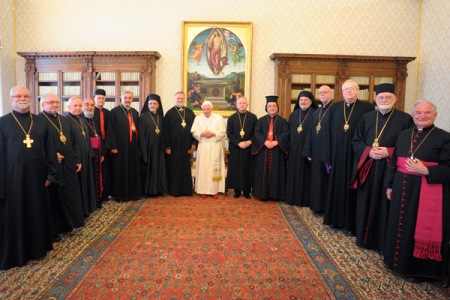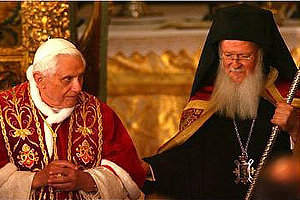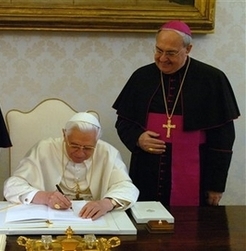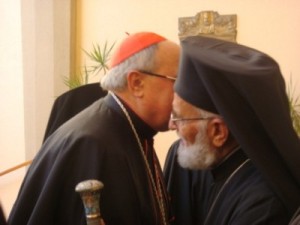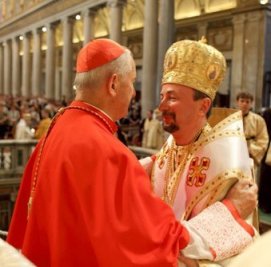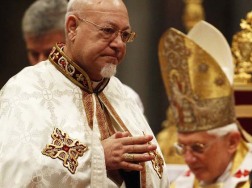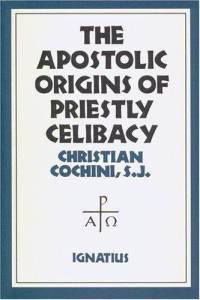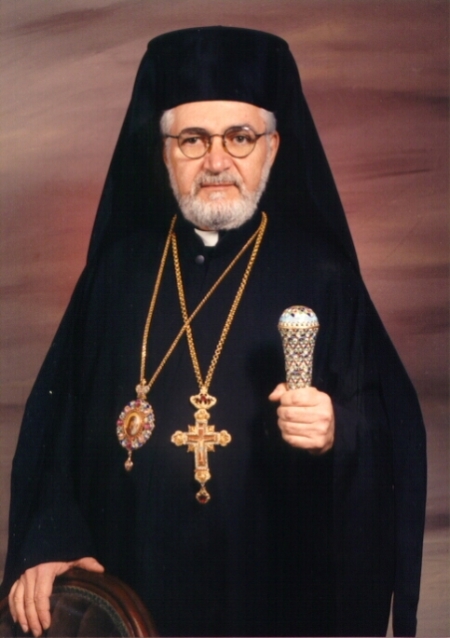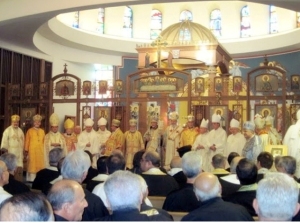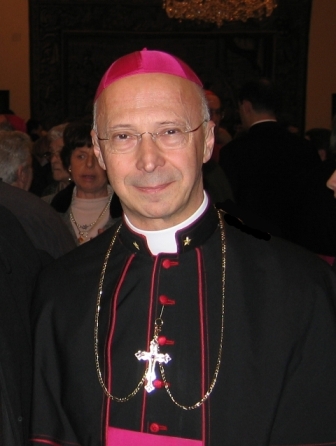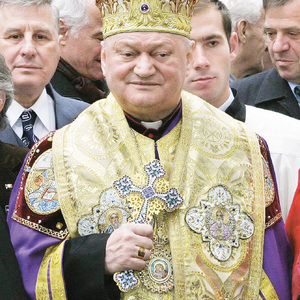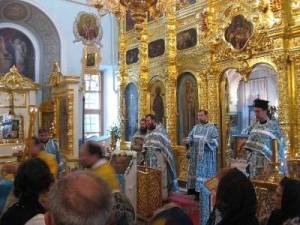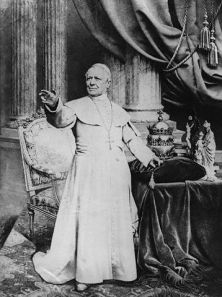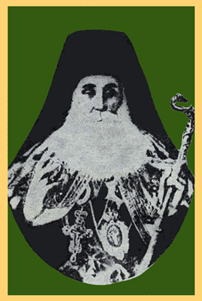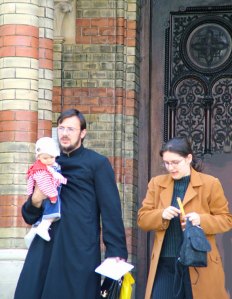
An earlier version of this article appeared soon after this blog began. It has since been greatly expanded with new research and recent developments noted. I beg the indulgence of long-time readers for this re-post for newer readers.
If, in the future, there is a reunited Church: Could Orthodox and Catholic parishes coexist with different disciplines — celibacy & married clergy?
The Question:
Catholic and Orthodox theologians and Bishops have been dialoguing with the eventual goal of solving their respective religious differences and working towards a reunion of the two Churches. There are varying views as to how successful the talks are proceeding or as to what issues must be resolved and which may not be as important. While the task might seem impossible to achieve, the doctrinal differences are not the focus of this article. Instead, imagine that the differences have somehow been solved or reconciled. Now, it’s time to live together. How will the two Churches’ differing views regarding priesthood and celibacy fit into this equation? Could they coexist?
The Problem:
The normative Roman Catholic position is that only single men can be ordained to the priesthood. Likewise, the Orthodox have celibate clergy, but they are usually required to take monastic orders, to fill the family void. However, Orthodox Bishops will also ordain married men to the priesthood. (Neither Church allows single men who have been ordained to later marry.) In a reunited Church, could Orthodox and Catholic parishes live side by side with people possibly transferring between parishes, one ordaining married men to the priesthood and one limiting it only to unmarried, single men?
A Microcosm of the Problem and its History
This tension has actually existed inside Catholicism itself. Many people are unaware that the Catholic Church actually has two disciplines regarding married priests. The Eastern Catholic Churches (Churches which, for the most part, reunited with Rome after breaking communion with Orthodoxy) actually permit a married clergy. One reason this is not as well known is because Eastern Catholics make up only about 2 per cent of the entire Catholic Church.
So we can take a look at the history and current status of these two disciplines already existing in the Catholic Church and this can help us evaluate whether the two disciplines could coexist if Catholicism and Orthodoxy were to reunite someday.
This difference in discipline already existing in the Catholic Church is explained in the Catechism of the Catholic Church:
1579 All the ordained ministers of the Latin Church, with the exception of permanent deacons, are normally chosen from among men of faith who live a celibate life and who intend to remain celibate “for the sake of the kingdom of heaven.” …
1580 In the Eastern Churches a different discipline has been in force for many centuries: while bishops are chosen solely from among celibates, married men can be ordained as deacons and priests. This practice has long been considered legitimate; these priests exercise a fruitful ministry within their communities….
Another reason the Eastern Catholic discipline of a married priesthood is relatively unknown is because it is generally restricted to the traditional homelands of these Eastern Catholic Churches. This can be seen in the Code of Canons of the Eastern Churches (the Eastern Catholic canon law). While Canon 373 states:
[T]he hallowed practice of married clerics in the primitive Church and in the tradition of the Eastern Churches throughout the ages is to be held in honor.
Canon 758 §3 refers to “special norms” established by the “Apostolic See” (the Pope) for ordaining married men:
The particular law of each Church sui iuris or special norms established by the Apostolic See are to be followed in admitting married men to sacred orders.
In practice, this means that according to Eastern Catholic canon law there is no restriction on Eastern Catholic Bishops ordaining married men to the priesthood in their home territories (Ukraine, Slovakia, Romania, the Middle East, etc.), but there are restrictions in place outside of their homelands.
This issue of restrictions on ordaining married men to the priesthood in other lands became a burning issue for some Eastern Catholics in the USA from about 1890-1935. But, first, a little more historical background of how this all developed.
Most of the different Eastern Catholic Churches arose in the 16th – 18th centuries as groups of Orthodox Christians decided to enter communion with Rome. The Ukrainian Greek Catholic Church, for example, concluded a formal accord called the Union of Brest in 1596. One point of the agreement was:
9. That the marriages of priests remain intact, except for bigamists.
In Eastern Europe, even today, a married priesthood is the norm for Ukrainian, Ruthenian, and Romanian Eastern Catholics, with thousands of married priests in the Eastern Catholic homelands. Married clergy is of absolutely no issue in areas where Eastern Christians predominate
But, when Eastern Catholics started emigrating to the United States from the Austro-Hungarian Empire in the latter part of the 19th century, they discovered that the idea of a married clergy was offensive to Roman Catholic Bishops and priests in the USA. The official website of the Byzantine Catholic Metropolia of Pittsburgh recounts the Vatican’s intervention to solve this conflict:
With tensions between the American Catholic bishops and the Greek Catholic clergy and faithful escalating, the Holy See in Rome intervened. In an attempt to clarify the situation, on October 1, 1890, the Holy See issued a decree concerning Greek Catholics in the United States. This decree instructed the newly arriving Greek Catholic priests to obtain jurisdiction from and to function under the authority of the local Roman Catholic bishop. Additionally, the decree stated all Greek Catholic priests functioning in America should be celibate. All married priests, according to the decree, should be recalled to Europe.
Rather than resolving the situation, the Vatican’s decree only served to exacerbate the relationship between the bishops, the Greek Catholic clergy and faithful. Inevitably, these differences between the American Catholic hierarchy and the Greek Catholic clergy and faithful ended in a schism.
At a meeting in Minneapolis, Minnesota, Father Alexis Toth was harshly rebuffed by the Roman Catholic Bishop John Ireland. The parish had no services that paschal season. Later that year Father Toth and his parish of 361 souls petitioned the Russian Orthodox bishop, residing at that time in San Francisco, to accept them under his jurisdiction. After investigations and exchanges of visits, this was accomplished. A zealous missionary, Father Toth, by the time of his death in 1909, brought fifteen Carpatho-Rusin parishes with over twenty thousand souls into the Orthodox Church.

An Eastern Catholic clergy meeting in 1890. Fr. Alexis Toth is seated third from the left.
The move to Orthodoxy, spurred on by the confrontation between Archbishop John Ireland and Fr. Alexis Toth (exacerbated when Ireland was told that Toth was a widower), laid a foundation for the Orthodox Church in America. Ea Semper, a 1907 papal decree, “reaffirmed celibacy” in the US Ruthenian Church. It is estimated by one source that by 1916, 163 Eastern Catholic parishes with 100,000 faithful had gone over to Orthodoxy. (St. Alexis Toth was canonized by the Orthodox Church in 1994.)
The Ruthenian Byzantine Catholic Church website details another schism over enforced celibacy by the Holy See on Greek
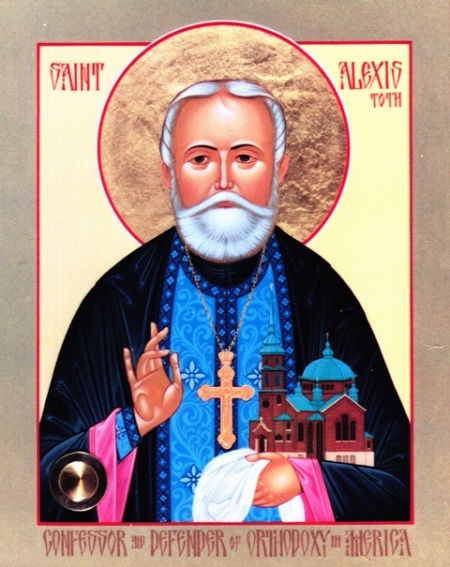
St Alexis Toth, canonized by the Orthodox Church in America in 1994, is viewed as helping to establish Orthodoxy in America
[Byzantine] Catholics, starting in the late 1920s:
In 1929, the Holy See issued a decree entitled Cum Data Fuerit. In this decree, the Holy See reiterated its previous position that the Greek Catholic clergy in America must be celibate….When the Holy See rebuffed all appeals, Bishop Takach insisted that the celibacy decree must be obeyed. Using the celibacy decree as a rallying cry allegedly to safeguard traditional Eastern traditions, some priests and laity started an open campaign against him and attacked his authority to govern the Exarchate. Many parishes were drawn into the conflict and numerous legal battles for control of church properties ensued. Regrettably, the conflict produced a schism within the Exarchate and led to the formation of the Independent Greek Catholic Church.
A contemporary analysis of the conflict appeared in Time magazine in 1937, and reflected back to its beginnings :
With the growth of Greek Rite Catholicism in the U. S.—it now numbers 1,000,000 faithful with 300 churches—the Roman hierarchy instituted a subtle campaign to Latinize its conduct. Feeling that a minority of married priests might cause envy among celibate Catholic priests, Pope Pius X in 1907 issued an apostolic letter enjoining celibacy upon all priests laboring in the U. S. In the same year he established the first U. S. Greek Catholic diocese, sent Bishop Stephen Soter Ortynski to fill it and enforce the order. So incensed were the Uniats—claiming that by the Treaty of Ungvar in 1646 their clergy had been granted the right to marry before ordination — that Carpatho-Russian and Ukrainian members of the church snubbed the papal letter. It remained unenforced.
Last week in Pittsburgh this old battle was once more raging. Its centre was the person of the fat, gimlet-eyed, Carpathian-born bishop of the Carpatho-Russians, Rt. Rev. Basil Takach. Sent to the U. S. in 1924, Bishop Takach had won instant approval by ordaining married men to the priesthood. But in 1929 another apostolic letter was issued by the Vatican, this one forbidding bishops to appoint married priests to Greek Rite posts. Bishop Takach obeyed the order, but in Bridgeport, Conn., a priest dared not only oppose it but circularized Greek Catholic churches to stir up more opposition. This priest, a widower named Rev. Orestes Peter Chornock, was thereupon removed from his rich, comfortable Bridgeport parish, rusticated to a tiny church in Roebling, N. J.
Last week, Bishop Takach, sitting tight in his episcopal residence in smoky Munhall, Pa., had a full-fledged revolt on his hands. Father Chornock was named bishop of a new, dissident faction, to be called the Carpatho-Russian Greek Catholic Diocese of the Eastern Rite, U. S. A. Bishop-elect Chornock’s diocese was born when 36 of Bishop Takach’s priests petitioned him to appeal the second papal order. Father Chornock and five other clergy were excommunicated by the Vatican. By last week their faction had grown to include 40 parishes, drew 300 lay and clerical delegates to a convention in Pittsburgh.
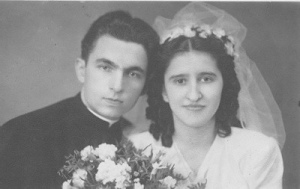
In 1929, Rome issued the document Cum Data Fuerit which forbade the ordination of married men to the priesthood in Eastern Catholic Churches in the USA.
The “celibacy wars” of this period are chronicled in depth in the bookHistorical Mirror (pp. 127-304), compiled by Fr. John Slivka, one of the last married men ordained to the priesthood in the Byzantine Catholic Church before the 1929 ban. The “Independent Greek Catholic Church,” led by Metropolitan Orestes Chornock, was received into Orthodoxy by the Ecumenical Patriarch of Constantinople in 1938 and is now known as the American Carpatho-Russian Orthodox Diocese (ACROD). The story is told from the ACROD point of view in the book Good Victory by Fr. Lawrence Barriger. Barriger’s book reproduces some information not found in Fr. Slivka’s book, including a document from the Roman Curia in 1934 explaining why the Pope was insisting on the ban on married clergy in the USA. The Cardinal in charge of the Oriental Congregation wrote:
This regulation [re: celibacy] arose not now, but anew, from the peculiar conditions of the Ruthenian population in the United States of America. There it represents an immigrant element and a minority, and it could not, therefore, pretend to maintain there its own customs and traditions which are in contrast with those which are the legitimate customs and traditions of Catholicism in the United States, and much less to have there a clergy which could be a source of painful perplexity or scandal to the majority of American Catholics….As regards their particular canonical discipline, the Holy See could not have affirmed its integral application at all times and in all places without taking into account the different exigencies and circumstances. Thus one can well understand how a married clergy, permitted in those places where the Greek Ruthenian Rite originated and constitutes a predominant element, could hardly be advisable in places where the same Rite has been imported and finds an environment and mentality altogether different. (Full text of letter can be found here.)
After this, the idea of a married clergy in the Eastern Catholic Churches was seen by some as something that was being phased out, even in the home territories. For example, in the 1950s Australian priests Rumble and Carty wrote the following in the popular apologetics series Radio Replies, (published with a preface written by Fulton J. Sheen):
These [Eastern Catholic] churches are gradually leaning towards the complete acceptance of celibacy, just as it prevails in the Western Church. Though the Holy See has not imposed the discipline of the Latin Church upon them, they are gradually imposing it as an obligation upon themselves….Today the great majority of priests in the Uniate [Eastern Catholic] Churches do not avail themselves of the right to marry before ordination. They voluntarily choose to remain single, and being ordained as single men, adopt celibacy as the law of their future lives. The time will certainly come when these Eastern Uniate Churches will wish to have the full discipline of the Latin Church in regard to celibacy extended to them also….[M]any of the Uniate Eastern Churches were for long periods separated from Rome by various Eastern heresies, and returned to unity with Rome only after having contracted habits rife amongst Eastern heretics. The Pope insisted that, on returning to the unity of the Catholic Church, they should renounce all heretical elements, and accept everything essential to the Catholic Faith. But in disciplinary matters, he did not desire to impose the full severity of Western regulations suddenly, preferring to lead them gradually to an appreciation of the higher Latin ideals. Provided the Eastern Churches are prepared to accept all the essential things, there is no reason why they should be excluded from the unity of the Church. And granted their submission, it is but reasonable to make allowance for their previous customs, and patiently wait for them to grow into the full discipline of the Church gradually. Of recent years this growth in the direction of a full acceptance of celibacy is most pronounced. (Volume 3, 1183, 1185)
However, this negative view towards a married clergy began to change after one of the decrees of Vatican II affirmed:
[Celibacy] is not demanded by the very nature of the priesthood, as is apparent from the practice of the early Church and from the traditions of the Eastern Churches. (Presbyterorum Ordinis, 16)
Still, it seems there is no agreement in the Catholic Church if the Eastern tradition of a married clergy is a “right,” or an exemption which is tolerated. The toleration model is how Radio Replies (Vol. 1, Sec. 1195) presented it in the early 20th century:
1195. Are there not Oriental Churches united to the Catholic Church, yet without the law of celibacy?
Yes. They have been exempted from the law obliging all Priests of the Latin Rite. The Church has tolerated the ancient custom of marriage in those Eastern Churches which have sought re-union with her, allowing married men to be ordained amongst them, though marriage subsequent to ordination is forbidden. But in the Western Latin Church the full law must be observed.
Does that view of married priests being an exemption to be tolerated still prevail?
The Post-Vatican II Situation
In 1978, Pope Paul VI wrote Melkite Greek Catholic Patriarch Maximos V after the Patriarch ordained a married American to serve the Melkite Eparchy (Diocese) in America, while he was visiting in Canada. The Pope termed the ordination “illicit” and the priestly faculties were removed. In the letter, Pope Paul VI asserted what he felt was his right to regulate this tradition and explained that having married priests in America
poses some delicate problems for the Latin-rite community. This is why the Holy See, as your Beatitude has been informed from time to time, has decided, on this particular point, to suspend the application of the general principle of the preservation of the traditions proper to Eastern communities outside their patriarchal territories. [Source, page 41]
Writing in an article in St. Vladimir’s Theological Quarterly in 1986, Melkite priest Fr. Philip Khairallah complained that things were still at an impasse regarding ordaining married men to the priesthood in the USA:
This question has still not been resolved. The five married priests now serving in the Eparchy are held in limbo. They have not officially been given pastoral assignments. Whenever the question has been raised, the answer has been that (1) the Patriarch and his Synod are still dialoguing with Rome, and are waiting a resolution to the problem, or (2) they have to wait until the new Canon Law for the Oriental Churches is promulgated. In ecumenical meetings with the Orthodox, one question is always asked: Why has Rome forbidden the Melkites to live according to their traditions, and if this is what is meant by being in communion with the Church of Rome, then will all the other Orthodox traditions go the same way? (St. Vladimir’s Theological Quarterly, Fall 1986, Page 210)
It is apparent that if the Eastern Catholic tradition of ordaining married men is a “right,” it is still subject to regulation by the Pope. This can be seen most clearly in what happened to the Ruthenian Byzantine Catholic Church when it canonically sought to restore a married priesthood. In 1998, the Ruthenian Church was set to promulgate, after consultation with Rome, its Particular Law (to be used in conjunction with the Eastern Catholic Canon Law). It received a “receptio“ or approval of the new laws from Rome in July of that year. Statute 44 of the new Law caused great excitement among Byzantine Catholics:
Statute 44 – 1. The Council of Hierarchs of the Metropolia of Pittsburgh notes the very clear direction of the Second Vatican Council’s Decree on the Eastern Churches, canons 373, 28, 39, and 40 of the Code of Canons of the Eastern Churches, paragraph 1 of Orientale Lumen, which direct a return to the original patrimony of the Eastern Catholic Churches. The Council of Hierarchs also notes that there is currently a married clergy in the Latin Church in the United States, and that it has been implemented without scandal to the faithful of the Latin Church.
2. This same Council of Hierarchs ascertains that the imposition of clerical celibacy introduced by the decree Cum data fuerit and reaffirmed by the decree Qua sollerti are currently in effect for the Ruthenians in the United States.
3. The Council of Hierarchs declares that these special restrictive norms imposed by the Apostolic See are no longer in force and, thus, in the Metropolia of Pittsburgh, marriage is not an impediment to presbyteral orders.
The first news dispatch about the new laws, written by a member of the canonical commission and published by a Byzantine Catholic newspaper in August 1998, was entitled “Married Priesthood Restored to U.S. Byzantine Church.” It gave these reasons for the restoration of the right to ordain married men and also noted the ecumenical implications:
The law concerning married priests is based on the decrees of the Second Vatican Council, Eastern canon law, and the pope’s apostolic letter Orientale lumen, all of which direct a return to their authentic patrimony by the Eastern Catholic churches.
The Council of Hierarchs, in commenting on this restoration of the married priesthood, noted that the retention of the married presbyterate was one of the conditions of the Union of Uzhorod, that the prohibition of married clergy for Eastern Catholics in the United States brought great harm to the church, that there are currently over 100 married Roman Catholic priests serving lawfully in the United States and that there has been no difficulty among the faithful of the Latin church, and, finally, ecumenical considerations vis-a-vis the Orthodox churches. The Byzantine bishops also noted their many efforts and successes in returning to the Eastern patrimony in the areas of liturgy and doctrinal teaching. (emphasis added)
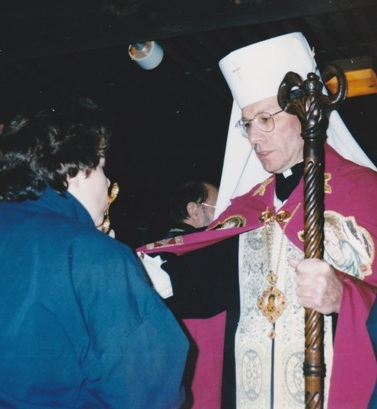
In 1999, Metropolitan Judson of the Ruthenian Byzantine Catholic Church promulgated canons which required dispensations from Rome before ordaining married men to the priesthood
However, some inaccurate initial press reactions by news media outside the Byzantine Church suggested a possible “showdown” between the Ruthenian Church and the Vatican and some conservative Catholic groups represented it as a rebellion against Rome. The upshot was that the Vatican withdrew its approval and stopped the promulgation of the “married priest’s statute.” A news report from 1999 explains:
Last year, [Metropolitan Judson] Procyk was set to announce that Rome had approved 50 new canons governing everything from seminary education to sacraments. One would have allowed Byzantine bishops in the United States to ordain married men without special permission.
But a conservative Catholic news organization misinterpreted the change as a revolt against Rome. The Vatican then placed all 50 laws on hold while talks continued between officials of the Vatican’s Congregation for Oriental Churches and Byzantine canon lawyers from the United States. The Vatican approved the final text this year.
It is speculated that the Eastern (Oriental) Congregation gave the original approval, only to have another section of the Curia in Rome get involved once some negative reactions reached Rome. The final version of the Ruthenian Particular Law, promulgated a year later, removed what had been called “the married priests’ statute” and reaffirmed the right of the Pope to regulate whether married men could be ordained, this time on a case by case basis:
Canon 758 §3 §2. Concerning the admission of married men to the order of the presbyterate, the special norms issued by the Apostolic See are to be observed, unless dispensations are granted by the same See in individual cases.
In the past ten years things seem to be lightening up somewhat. One Eastern Catholic webpage notes a few ordinations of married men (after being vetted by Rome) have occurred in the USA. Many more ordinations have happened in Canada (and a few in the USA) in the Ukrainian Greek Catholic Church. Other news reports state these ordinations are “allowed by Rome,” but are done “with little fanfare to avoid attention,” and “celebrated quietly.” The Melkite Greek Catholic Church ordained one married deacon to the priesthood in 1996 with no public response from Rome. (See “A Quiet Revolution,” from Catholic World Report, March 1997.) However, subsequent ordinations of married deacons to the priesthood in the American Melkite Church have occurred in the Middle East where the Ban does not apply.
In 1998, the Australian Catholic Bishops Conference, reversing a previous stance, went on record to state they had no objection to the ministry of married Eastern Catholic priests. Yet, tensions still exist in some places between Eastern Catholic and Roman Catholic Bishops over this matter. In 2002, the Italian Bishops’ Conference (CEI) asked the Ukrainian Catholic Church to not send any married priests to staff Ukrainian Catholic parishes in Italy because “they would create confusion among our faithful.” Chiesa news reported:
And as long as each group stays in its respective country of origin, it’s okay with the Vatican. But as soon as married Eastern priests emigrate and mingle with the celibates, Rome enters a state of alarm. The Vatican has asked Western bishops to raise a barrier and the CEI did so immediately, as did other European episcopates.
The same source notes a 1998 directive from the Vatican Secretary of State that married Ukrainian Catholic priests leave Poland and return to Ukraine was eventually reversed after interventions by other Cardinals. Helping to resolve that conflict was determining that the historic Ukrainian Catholic territory includes part of what is now Poland (due to border changes over the years), and so it was determined that these married priests were not working outside of their historic homeland after all. That 1998 news report highlighted this issue of “canonical territory,” explaining that
According to canon law for Churches of the Eastern Rite, the ordination of married men is allowed. However, the reported request from the Vatican says that the paragraph of the canon law governing the issue [ordaining married men to the priesthood] is valid only in traditionally Eastern-rite countries, but not in the countries where Eastern-rite Catholics have immigrated.
Accordingly, this later article notes the concept of territory is still considered important:
But the dominant position in the curia remains that of cuius regio eius est religio: no mingling between celibate and married priests in the same territory.
In 2010, Italian news sources were reporting that the Italian Bishops’ Conference was blocking the introduction of married Romanian Catholic priests to serve the estimated 500,000 Romanian Catholics in Italy to “prevent possible confusion among the faithful.” At issue, again, is the concept of “canonical territory.” These news reports also noted that the papal regulation of married clergy in the Eastern Catholic Churches outside of their home territories still remains:
On 20 February 2008, the regular meeting of the Congregation for the Doctrine of the Faith reaffirmed the validity of the norm of a binding obligation of celibacy for priests of Eastern Catholic Churches who exercise the ministry outside the canonical territory. The pope, however, has given the Congregation for the Eastern Churches the authority to give a dispensation from this norm, with the approval of the Episcopal Conference in question. (Translated from this Italian news source.)
These more recent events above demonstrate that the conflict between Roman and Eastern Catholics over a married priesthood is not something that belongs to the past, but still has reverberations today.
Recent Calls to Remove the Ban
In 2009, Fr. Lawrence Barriger, writing in the ACROD publication Church Messenger, noted the 80th anniversary of the 1929 Vatican decree Cum Data Fuerit and proposed two things Pope Benedict XVI could do to improve ecumenical relations over this issue:
The tragedy is that Rome, eighty years later, is still unwilling to regard the Byzantine-Rite Catholic Church in the United States as anything but a tolerated Church. In recent years the Byzantine-Rite Church attempted to secure the restoration of the married priesthood in the United States once again. The Vatican reaffirmed the celibacy provision of Cum Data Fuerit by its refusal to act on the request of the Byzantine Church.
If Pope Benedict really wanted to demonstrate his understanding of and regret for the divisions in families and the heartaches that Cum Data Fuerit had caused in the Byzantine Church since 1929 he could do two things. In the external forum he could rescind the excommunication of Metropolitan Orestes Chornock with the admission that his return to Orthodoxy was done out of the love of his Church and people which Rome, wittingly or unwittingly, was in the process of destroying.
Internally the Pope could rescind the celibacy provision of Cum Data Fuerit to demonstrate that Rome no longer regards our Eastern Rite brothers and sisters as unwanted and unloved, subject to the needs and prejudices of the American Roman Catholic Church. Until then we can only conclude that no matter how “Eastern” services appear in the Byzantine Church that it is still fundamentally simply a group of Roman Catholics who have a “different Mass.” (February 22, 2009) p. 4
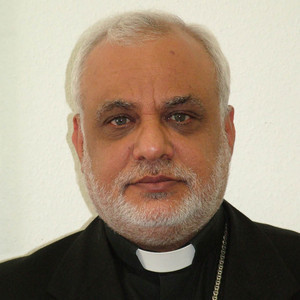
In 2010, Coptic Catholic Bishop Aziz Mina called for the end of the Ban on ordaining married men outside of traditional Eastern Catholic homelands
In 2010, at the Special Assembly for the Middle East of the Synod of Bishops held in Rome, Coptic Catholic Bishop Aziz Mina from Guizeh, Egypt made a call for the end of the Ban on ordaining married men outside of the traditional homelands of the Eastern Catholic Churches. According to Catholic News Service:
The Coptic bishop also asked Pope Benedict XVI to revoke a decision made in the 1930s that Eastern churches can ordain married men only in their traditional homelands.
The Holy See Press Office also reported on Bishop Aziz Mina’s speech on the Vatican website. Proposition 23 from the Final List of Propositions sent to Pope Benedict XVI for the Synod of Catholic Bishops for the Middle East (dated 23 October 2010) included this request:
Propositio 23
Married Priests
Clerical celibacy has always and everywhere been respected and valued in the Catholic Churches, in the East as in the West. Nonetheless, with a view to the pastoral service of our faithful, wherever they are to be found, and to respect the traditions of the Eastern Churches, it would be desirable to study the possibility of having married priests outside the patriarchal territory.

Cardinal Antonios Naguib has asked Pope Benedict XVI to remove the restriction against married Coptic Catholic priests outside of Egypt.
Coptic Catholic Patriarch Cardinal Antonios Naguib referred to this request for permission to ordain married priests for Coptic Catholic parishes in the USA while on a parish visitation in Nashville, Tennessee in July, 2011. The Patriarch explained to the local press that the Coptic tradition allows
married priests. But canon law only allows married priests to serve in Egypt, and the priests serving the diaspora around the world must be celibate.
He added that
The Coptic Catholic Church has appealed to Rome to lift that rule…
It is too early to gauge what the reaction from Pope Benedict XVI will be to this request.
Why are some Eastern Catholics ordaining married men outside their traditional homelands but others aren’t?
UPDATE: November 23, 2011 — For updated information on the Ban and how it is currently applied, see the article: Vatican: Ban on Ordaining Married Men in Western Lands is Not Dead.
So, why are married Eastern Catholic priests starting to appear in some parishes (for example, in the Ukrainian Greek Catholic Church in Canada and the USA), but are more closely regulated (for example, in the Ruthenian Byzantine Catholic Metropolia of Pittsburgh), or are not permitted (for example, the Coptic Catholic Church parishes in the USA or the parishes of the Romanian Byzantine Catholic Church in Italy)? This appears to be tied to three factors:
1) The status of the Particular Law for that Eastern Catholic Church
2) Whether that Eastern Catholic Church has its own parallel hierarchy in place
3) And, if that Eastern Catholic Church has its own parallel hierarchy, do the Bishops of that Eastern Catholic Church encounter opposition from the local Latin Rite Bishops?
For example, the Particular Law (an addendum to the Eastern Code of Canons) of the Ruthenian Byzantine Catholic Metropolia of Pittsburgh only applies to the American Church. As noted earlier, the statute requiring dispensations for the ordination of married men was imposed by Rome and made a part of their Particular Law in 1999. This happened after complaints were made by some in the Latin Rite to the earlier version which would have permitted the ordination of married men. Other Eastern Catholic Churches (such as the Ukrainian and Melkite Churches) have their own Particular Laws, but these were formulated inside the traditional homelands and do not address the issue of ordaining married men outside their the homelands. As a result, the Ruthenians in the USA have had the unfortunate experience of having the restriction explicitly spelled out in their canon law.
Parishes of Eastern Catholic Churches which do not have a parallel hierachy in place (such as the Coptic Catholics in the USA or the Romanian Byzantine Catholics in Italy) usually end up following the celibacy rule because their parishes are subject to Latin Bishops. So, Catholic Coptic parishes in the USA become subject to the Ban. With no parallel heirarchy in Italy, the Romanian Byzantine Catholic Church ends up being required to only send in celibate priests because their parishes in Italy are overseen by Italy’s Latin Rite Bishops.
The situation is different for the Ukrainian Catholic Church in Canada (UGCC) and the USA as it has its own parallel hierarchy in place. UGCC parishes there are not subject to the Latin Rite Bishops but to their own Ukrainian Catholic Bishops. As noted earlier, some Ukrainian Catholic Bishops have been quietly ordaining married men to the priesthood in UGCC parishes in the USA and Canada. How has this been received by Rome?
In discussing this situation, the Catholic weekly America reported in 2003 that the Vatican is not suspending such married men who are ordained to the priesthood in Western lands:
Despite a rule the Vatican insists is still in force, it has stopped suspending married men ordained to the priesthood for service in the Eastern Catholic churches of North America and Australia. The ordinations are occurring regularly, although they are not great in number, and they are celebrated quietly. “Rome will allow the ordinations, but it does not want a bishop to ordain married men, then splash pictures all over the place,” said the Rev. Kenneth Nowakowski, rector of Holy Spirit Seminary in Ottawa and spokesman for the Ukrainian bishops of Canada.
However, the Ban is viewed as “unchanged”:
Msgr. Lucian Lamza, an official in the Vatican’s Congregation for Eastern Churches, said on May 22 that the Vatican’s ban on the ordination of married men for the Eastern churches in the West “remains unchanged.” The ordinations “are against the norm,” he said. “But, of course, these priests can validly celebrate the liturgy and sacraments,” since the ordinations are sacramentally valid. He would not discuss the Vatican’s reaction or lack of reaction to the ordinations.
Questions that remain
Can East and West coexist regarding married priests? Certainly, the relationship between the Eastern and Roman Catholic Churches on the issue of married clergy has seen an improvement over conditions that obtained throughout most of the 20th century. Still, there are many questions that remain that prevent a clear answer if conditions are such that West and East could peacefully live together with these two traditions in place.
Why must Eastern Catholics still live with restrictive rules regarding ordaining married men in many countries which have a large Roman Catholic presence? Would Orthodox need to live similarly in a reunited Church?
In a reunited Church, would the Latin Church feel a need to ask for special cooperation from the Eastern Churches on this issue? For example, would future candidates for ordination from Eastern Churches in a reunited Church need dispensations from Rome, thus ensuring, for example, that men from Western parishes weren’t going over to the East to get ordained?
Would ordinations of married men in Eastern Churches need to be done quietly? Or, could both Churches (West and East) live side-by-side with the differing traditions without any restrictions?
Finally, would the Orthodox tradition of a married clergy be viewed as a custom that is tolerated and subject to regulation by the Pope, or as a right?
For further reading:
A Critical Consideration of The Case for Clerical Celibacy
Fr. Touze and Roman Miopia
Romance Blooms in a Catholic Seminary for Fr. Roman
 The retention of a married clergy was the ninth of the thirty-three Articles of the Union of Brest outlined in June 1595. True, these articles only expressed the Ruthenian bishops’ desiderata, and were neither accepted nor rejected by the Holy See (see Borys Gudziak, Kryza i reforma, L’viv 2000, pp. 296-97.) The right to a married clergy was reaffirmed, however, at the Synod of Zamosc in 1720 and the Lviv provincial synod of 1891. But in 1918, separate provision was made at the LvivGreek-Catholic seminary for candidate priests seeking ordination as celibates, and in the 1920s, mandatory celibacy was introduced in the Stanyslaviv (now Ivano-Frankivs’k) and Peremyshl’ (now Przemysl) seminaries. Nonetheless, in today’s Ukraine married men may be ordained as Greek-Catholic priests.
The retention of a married clergy was the ninth of the thirty-three Articles of the Union of Brest outlined in June 1595. True, these articles only expressed the Ruthenian bishops’ desiderata, and were neither accepted nor rejected by the Holy See (see Borys Gudziak, Kryza i reforma, L’viv 2000, pp. 296-97.) The right to a married clergy was reaffirmed, however, at the Synod of Zamosc in 1720 and the Lviv provincial synod of 1891. But in 1918, separate provision was made at the LvivGreek-Catholic seminary for candidate priests seeking ordination as celibates, and in the 1920s, mandatory celibacy was introduced in the Stanyslaviv (now Ivano-Frankivs’k) and Peremyshl’ (now Przemysl) seminaries. Nonetheless, in today’s Ukraine married men may be ordained as Greek-Catholic priests.


 Posted by orthocath
Posted by orthocath 